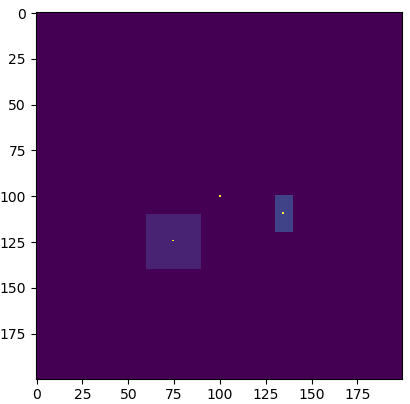2 回答
TA贡献1851条经验 获得超4个赞
我解决了这个问题。
因为两个3D数组太大了。所以首先我用最近邻法将它们采样到更小的尺寸。然后继续:
import numpy as np
from scipy import spatial
import time
sub_image1 = np.ones((30, 30, 30))
sub_image2 = np.ones((20, 10, 15))
# pad the two sub_images to same shape (1200, 1200, 1200) to simulate my 3D medical data
img_1 = np.pad(sub_image1, ((1100, 70), (1100, 70), (1100, 70)))
img_2 = np.pad(sub_image1, ((1100, 80), (1130, 60), (1170, 15)))
ori_sz = np.array(img_1.shape)
trgt_sz = ori_sz / 4
zoom_seq = np.array(trgt_sz, dtype='float') / np.array(ori_sz, dtype='float')
img_1 = ndimage.interpolation.zoom(img_1, zoom_seq, order=0, prefilter=0)
img_2 = ndimage.interpolation.zoom(img_2, zoom_seq, order=0, prefilter=0)
print("it cost this secons to downsample the nearer image" + str(time.time() - t0)) # 0.8 seconds
def nerest_dis_to_center(img):
position = np.where(img > 0)
coordinates = np.transpose(np.array(position)) # get the coordinates where the voxels is not 0
cposition = np.array(img.shape) / 2 # center point position/coordinate
distance, index = spatial.KDTree(coordinates).query(cposition)
return distance
t1 = time.time()
d1 = nerest_dis_to_center(img_1)
d2 = nerest_dis_to_center(img_2)
if d1 > d2:
print("img2 object is nearer")
elif d2 > d1:
print("img1 object is nearer")
else:
print("They are the same far")
t2 = time.time()
print("used time: ", t2-t1)
# 1.1 seconds
TA贡献1772条经验 获得超5个赞
这可能不是最终的解决方案或最佳的运行时间,必须用实际数据进行测试。为了表达我的想法,我选择了较小的矩阵大小并且仅使用 2D 情况
import numpy as np
import matplotlib.pyplot as plt
sub_image1 = np.ones((30, 30)) # 1st object
sub_image2 = np.ones((20, 10)) * 2 # 2nd object
# pad the two sub_images to same shape (120, 120)
img_1 = np.pad(sub_image1, ((110, 60), (60, 110)))
img_2 = np.pad(sub_image2, ((100, 80), (130, 60)))
final_image = img_1 + img_2 # creating final image with both objects in a background of zeros
image_center = (np.array([final_image.shape[0], final_image.shape[1]]) / 2).astype(np.int)
# mark the center
final_image[image_center[0], image_center[1]] = 10
# find the coordinates of where the objects are
first_obj_coords = np.argwhere(final_image == 1) # could be the most time consuming operation
second_obj_coords = np.argwhere(final_image == 2) # could be the most time consuming
# find their centers
first_obj_ctr = np.mean(first_obj_coords, axis=0)
second_obj_ctr = np.mean(second_obj_coords, axis=0)
# turn the centers to int for using them to index
first_obj_ctr = np.floor(first_obj_ctr).astype(int)
second_obj_ctr = np.floor(second_obj_ctr).astype(int)
# mark the centers of the objects
final_image[first_obj_ctr[0], first_obj_ctr[1]] = 10
final_image[second_obj_ctr[0], second_obj_ctr[1]] = 10
# calculate the distances from center to the object center
print('Distance to first object: ', np.linalg.norm(image_center - first_obj_ctr))
print('Distance to second object: ', np.linalg.norm(image_center - second_obj_ctr))
plt.imshow(final_image)
plt.show()
输出
Distance to first object: 35.38361202590826
Distance to second object: 35.17101079013795

添加回答
举报
